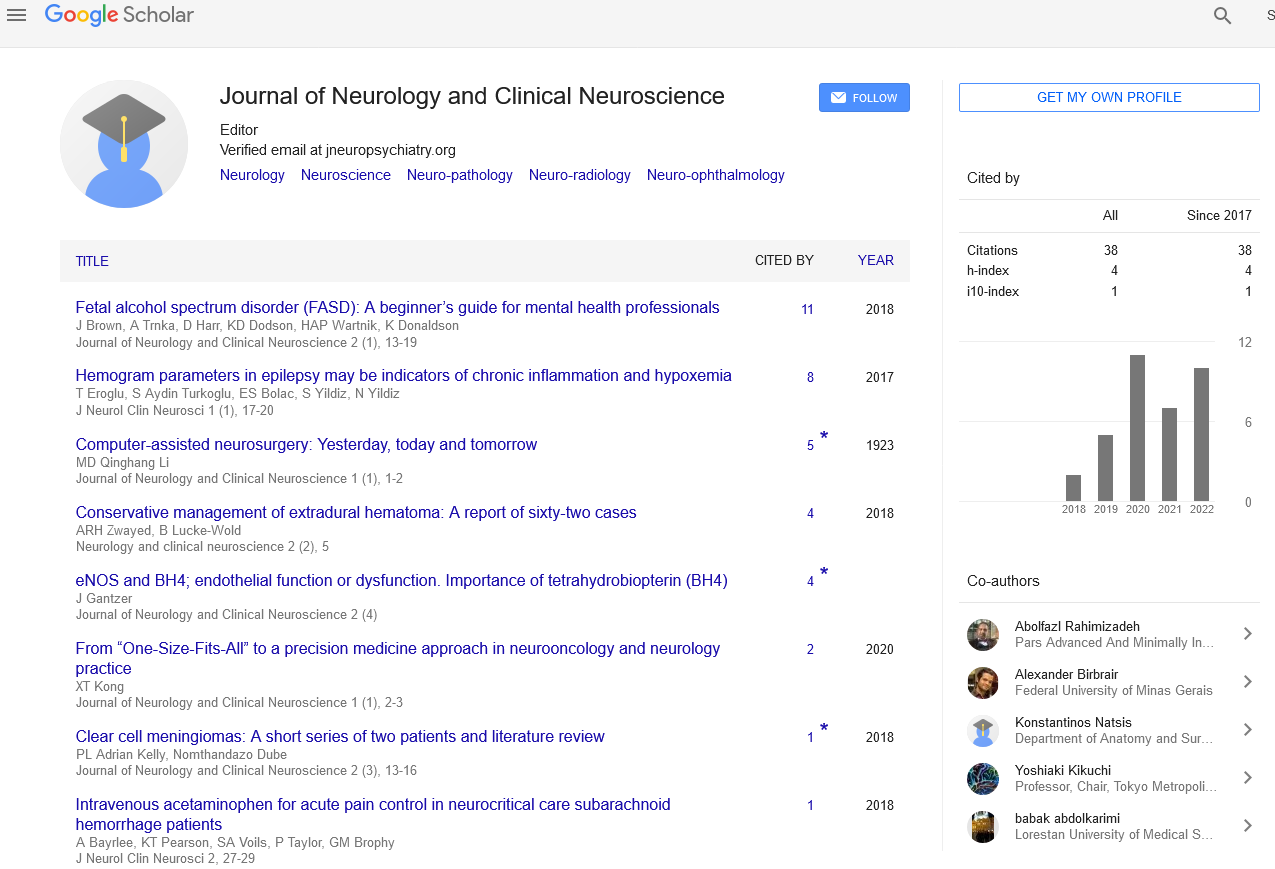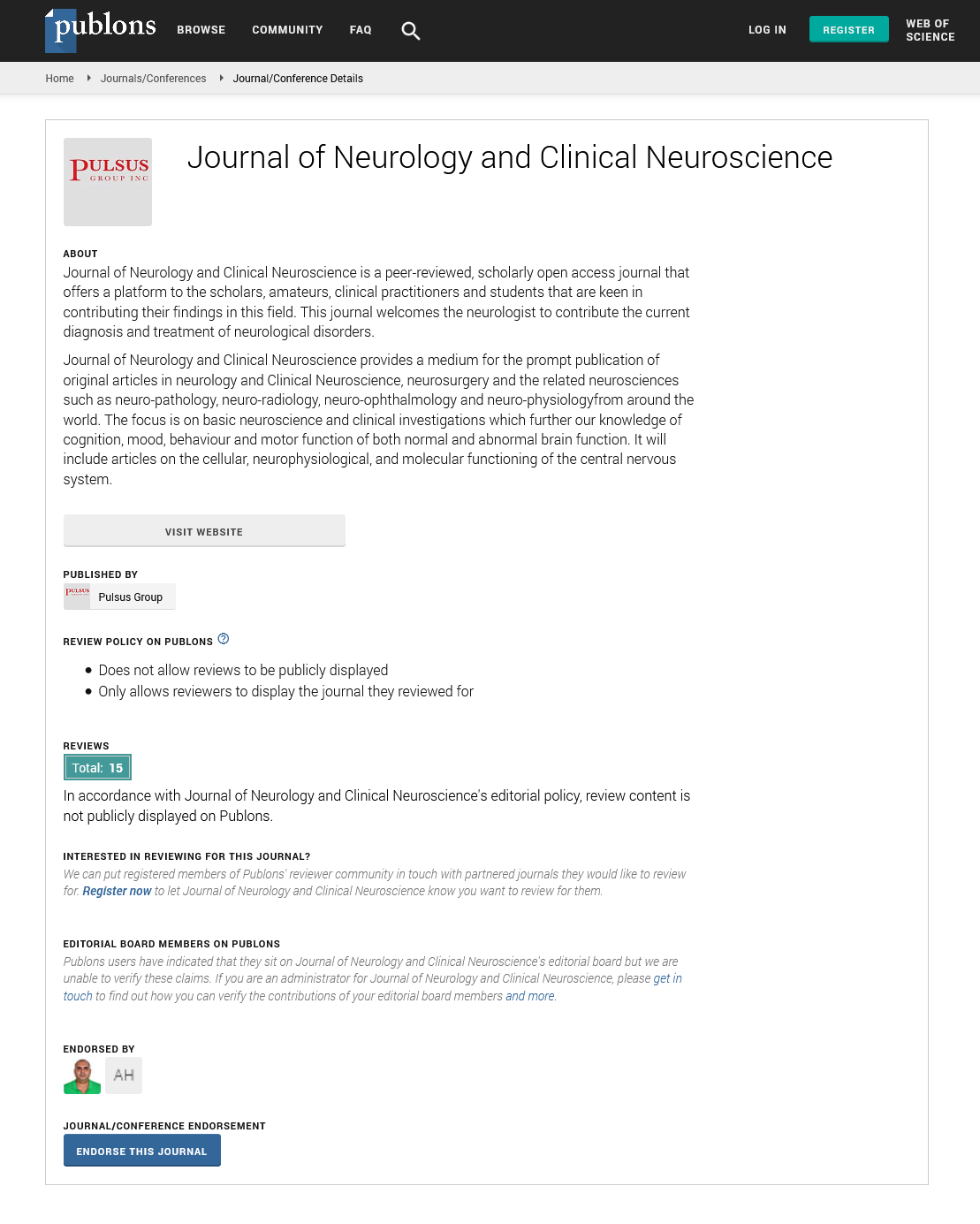Futility vs. functional independence: mechanical thrombectomy in elderly populations
Received: 20-Dec-2017 Accepted Date: Jan 02, 2018; Published: 04-Jan-2018
Citation: Adcock AK. Futility vs. functional independence: mechanical thrombectomy in elderly populations. J Neurol Clin Neurosci. 2017;2(1):4.
This open-access article is distributed under the terms of the Creative Commons Attribution Non-Commercial License (CC BY-NC) (http://creativecommons.org/licenses/by-nc/4.0/), which permits reuse, distribution and reproduction of the article, provided that the original work is properly cited and the reuse is restricted to noncommercial purposes. For commercial reuse, contact reprints@pulsus.com
Editorial
Ischemic stroke continues to be one the leading causes of death and disability worldwide [1] Thrombolysis with intravenous reverse plasminogen activator (IV-tPA) remained the mainstay treatment for the acute ischemic stroke patient until multiple trials examining Mechanical Thrombectomy (MT) with clot retrievers were positive in 2015 [2,3]. However the effectiveness of both intravenous and endovascular therapies are limited by their ultimate adoption across different patient populations. Outcomes of elderly patients with large vessel strokes undergoing Mechanical Thrombectomy (MT) are largely unknown as they were excluded from most randomized clinical trials [4]. A review of the National Inpatient Sample (NIS) federal database (through year 2011) indicated that elderly individuals undergoing MT were twice as likely to die in the course of their hospitalization. These data however, are fundamentally confounded by heterogeneity and an inability to identify patients with similar stroke burden as the comparator group. Thus, using this type of data to extrapolate poor outcomes in elderly patients undergoing MT is problematic.
Citing futility, deferring treatment with IV- tPA in elderly populations was once common practice [5]. Although octogenarians fare worse than their younger stroke counterparts [6], they still have better outcomes when treated with IV-tPA [7].
Therefore, strokologists should make every effort to evaluate our elderly stroke patients for acute stroke therapies. In regard to endovascular reperfusion, we retrospectively analyzed patients 80 years and older admitted with acute ischemic stroke over the previous 7 years in our own institution. Overall patients did poorly however, those who underwent MT were less likely to die. Surprising observations included that this decrease in mortality was not explained by a higher rate of complications in the control group and last seen normal (LSN) to groin puncture was not a significant predictor of poor outcome.
Others have demonstrated that elderly patients may still benefit from MT [8]. It is especially meaningful to improve a patient’s ability to achieve functional independence in a population who previously rarely survived their index stroke.
Large vessel stroke in elderly patients is indicative of a poor prognosis in general [6]. However, current investigations suggest that patients treated with MT may do better than untreated and certainly do not fare worse, arguing against exclusion based solely on age. Interestingly, time to groin puncture may not be a significant predictor of poor outcome, suggesting that wakeup strokes might still derive a benefit from treatment [9,10]. For better guidance, further studies dedicated to the elderly population are warranted. Barring prospective studies, a more comprehensive review could yield valuable information using a larger database. American Heart Association’s Get With the Guidelines (GWTG) recently added the necessary data points for MT patients potentially allowing for such meaningful analyses in the near future. In the meantime, evaluation of baseline functional status, medical comorbidities, and goals of care should guide management in elderly patients with an acute large vessel occlusion.
REFERENCES
- Kuklina EV, Tong X, George MG, et al. Epidemiology and prevention of stroke: a worldwide perspective. Expert Rev Neurother. 2012;12(2):199-208.
- Palaniswami M, Yan B. Mechanical Thrombectomy Is Now the Gold Standard for Acute Ischemic Stroke: Implications for Routine Clinical Practice. Interv Neurol. 2015;4(1-2): 18-29.
- Wahlgren N, Moreira T, Michel P, et al. Mechanical thrombectomy in acute ischemic stroke: Consensus statement by ESO-Karolinska Stroke Update 2014/2015, supported by ESO, ESMINT, ESNR and EAN. Int J Stroke. 2016;11(1):134-147.
- Goyal M, Menon BK, Van Zwam WH, et al. Endovascular thrombectomy after large-vessel ischaemic stroke: a meta-analysis of individual patient data from five randomised trials. The Lancet. 2016;387(10029):1723-31.
- Barber P, Zhang J, Demchuk A, et al. Why are stroke patients excluded from TPA therapy? An analysis of patient eligibility. Neurology. 2001;56(8):1015-20.
- Engelter ST, Bonati LH, Lyrer PA. Intravenous thrombolysis in stroke patients of ≥ 80 versus< 80 years of age-a systematic review across cohort studies. Age and ageing. 2006;35(6):572-80.
- To CY, Rajamand S, Mehra R, et al. Outcome of mechanical thrombectomy in the very elderly for the treatment of acute ischemic stroke: the real world experience. Acta Radiol Short Reports. 2015;4(9): 2058460115599423.
- Mohlenbruch M, Pfaff J, Schonenberger S, et al. Endovascular stroke treatment of nonagenarians. Am J Neuroradiol. 2017;38(2):299-303.
- Söderqvist ÅK, Andersson T, Wahlgren N, et al. Mechanical Thrombectomy in Acute Ischemic Stroke—Patients with Wake-Up Stroke and the Elderly May Benefit as Well. J Stroke Cerebrovasc Dis. 2016;25(9):2276-83.
- Tanne D, Gorman MJ, Bates VE, et al. Intravenous tissue plasminogen activator for acute ischemic stroke in patients aged 80 years and older. Stroke. 2000;31(2):370-5.





